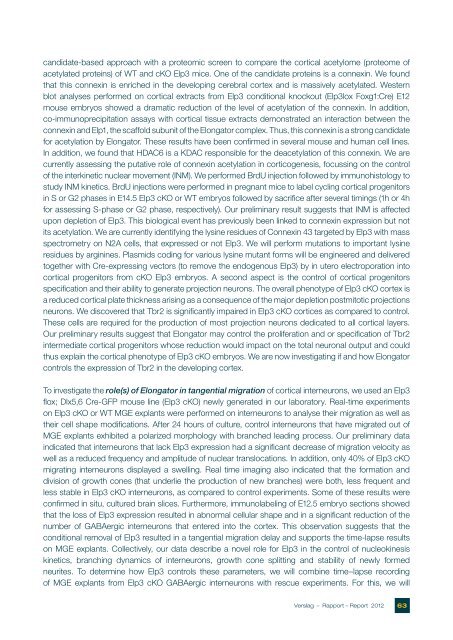Verslag – Rapport – Bericht – Report - GSKE - FMRE
Verslag – Rapport – Bericht – Report - GSKE - FMRE
Verslag – Rapport – Bericht – Report - GSKE - FMRE
You also want an ePaper? Increase the reach of your titles
YUMPU automatically turns print PDFs into web optimized ePapers that Google loves.
candidate-based approach with a proteomic screen to compare the cortical acetylome (proteome of<br />
acetylated proteins) of WT and cKO Elp3 mice. One of the candidate proteins is a connexin. We found<br />
that this connexin is enriched in the developing cerebral cortex and is massively acetylated. Western<br />
blot analyses performed on cortical extracts from Elp3 conditional knockout (Elp3lox Foxg1:Cre) E12<br />
mouse embryos showed a dramatic reduction of the level of acetylation of the connexin. In addition,<br />
co-immunoprecipitation assays with cortical tissue extracts demonstrated an interaction between the<br />
connexin and Elp1, the scaffold subunit of the Elongator complex. Thus, this connexin is a strong candidate<br />
for acetylation by Elongator. These results have been confirmed in several mouse and human cell lines.<br />
In addition, we found that HDAC6 is a KDAC responsible for the deacetylation of this connexin. We are<br />
currently assessing the putative role of connexin acetylation in corticogenesis, focussing on the control<br />
of the interkinetic nuclear movement (INM). We performed BrdU injection followed by immunohistology to<br />
study INM kinetics. BrdU injections were performed in pregnant mice to label cycling cortical progenitors<br />
in S or G2 phases in E14.5 Elp3 cKO or WT embryos followed by sacrifice after several timings (1h or 4h<br />
for assessing S-phase or G2 phase, respectively). Our preliminary result suggests that INM is affected<br />
upon depletion of Elp3. This biological event has previously been linked to connexin expression but not<br />
its acetylation. We are currently identifying the lysine residues of Connexin 43 targeted by Elp3 with mass<br />
spectrometry on N2A cells, that expressed or not Elp3. We will perform mutations to important lysine<br />
residues by arginines. Plasmids coding for various lysine mutant forms will be engineered and delivered<br />
together with Cre-expressing vectors (to remove the endogenous Elp3) by in utero electroporation into<br />
cortical progenitors from cKO Elp3 embryos. A second aspect is the control of cortical progenitors<br />
specification and their ability to generate projection neurons. The overall phenotype of Elp3 cKO cortex is<br />
a reduced cortical plate thickness arising as a consequence of the major depletion postmitotic projections<br />
neurons. We discovered that Tbr2 is significantly impaired in Elp3 cKO cortices as compared to control.<br />
These cells are required for the production of most projection neurons dedicated to all cortical layers.<br />
Our preliminary results suggest that Elongator may control the proliferation and or specification of Tbr2<br />
intermediate cortical progenitors whose reduction would impact on the total neuronal output and could<br />
thus explain the cortical phenotype of Elp3 cKO embryos. We are now investigating if and how Elongator<br />
controls the expression of Tbr2 in the developing cortex.<br />
To investigate the role(s) of Elongator in tangential migration of cortical interneurons, we used an Elp3<br />
flox; Dlx5,6 Cre-GFP mouse line (Elp3 cKO) newly generated in our laboratory. Real-time experiments<br />
on Elp3 cKO or WT MGE explants were performed on interneurons to analyse their migration as well as<br />
their cell shape modifications. After 24 hours of culture, control interneurons that have migrated out of<br />
MGE explants exhibited a polarized morphology with branched leading process. Our preliminary data<br />
indicated that interneurons that lack Elp3 expression had a significant decrease of migration velocity as<br />
well as a reduced frequency and amplitude of nuclear translocations. In addition, only 40% of Elp3 cKO<br />
migrating interneurons displayed a swelling. Real time imaging also indicated that the formation and<br />
division of growth cones (that underlie the production of new branches) were both, less frequent and<br />
less stable in Elp3 cKO interneurons, as compared to control experiments. Some of these results were<br />
confirmed in situ, cultured brain slices. Furthermore, immunolabeling of E12.5 embryo sections showed<br />
that the loss of Elp3 expression resulted in abnormal cellular shape and in a significant reduction of the<br />
number of GABAergic interneurons that entered into the cortex. This observation suggests that the<br />
conditional removal of Elp3 resulted in a tangential migration delay and supports the time-lapse results<br />
on MGE explants. Collectively, our data describe a novel role for Elp3 in the control of nucleokinesis<br />
kinetics, branching dynamics of interneurons, growth cone splitting and stability of newly formed<br />
neurites. To determine how Elp3 controls these parameters, we will combine time<strong>–</strong>lapse recording<br />
of MGE explants from Elp3 cKO GABAergic interneurons with rescue experiments. For this, we will<br />
<strong>Verslag</strong> <strong>–</strong> <strong>Rapport</strong> <strong>–</strong> <strong>Report</strong> 2012 63
















